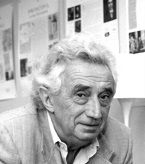
Igor Ekhiel’evich Dzyaloshinskii
Professor Emeritus of Physics and Astronomy
Igor Ekhiel’evich Dzyaloshinskii, who made groundbreaking contributions that span the entire field of theoretical condensed matter physics, died on 14 July 2021 in Irvine, California. His name and scientific legacy have already been immortalized in the areas of magnetism, low-dimensional conductors, liquid crystals, and applications of methods of quantum field theory.
Igor was born on 1 February 1931 in Moscow. His father died in German captivity in 1942 during the World War II. As a schoolboy, Igor worked in the car repair shop for food stamps in the postwar city and was the first member in his family to attend a university. He graduated from Moscow State University in 1953.
At age 21, while still a student, after passing infamous “theoretical minimum” exams, he joined the “Landau school” (named after its intellectual leader, Lev Landau), an informal circle of some of the best theoretical physicists of that time. Igor received the Ph.D. degree in 1957 and the Doctor of Science (habilitation) degree in 1962, both from the Institute for Physical Problems, Moscow.
Already in one of his first publications, in 1957, as part of his PhD thesis work, Igor outlined a set of elegant symmetry arguments that explained the puzzling phenomenon of “weak ferromagnetism” — the occurrence of a small net magnetization in select magnets. Later, Toru Moriya identified the microscopic mechanism of such an effect, which is now known as the Dzyaloshinskii–Moriya interaction, present in most magnets.
With his remarkable insight, and as part of the same PhD thesis, Igor suggested a mechanism of the magnetoelectric effect and predicted piezomagnetism: magnetization induced by stress and deformation caused by a magnetic field.
Those conceptual results are the cornerstones of the field of magnetism. The symmetry approach Igor pioneered early in his career has been widely used and has given rise to new directions. It is fair to say that the blossoming modern fields of spintronics — which is concerned with electron spin and applications in electronic devices — and of multiferroics — the study of materials with coexisting magnetism and ferroelectricity — both take their origin from the foundational works by Igor more than half a century after their publications.
Another long-lasting impact of Igor’s research from the same era was the application of the methods of quantum field theory. Igor, together with Lev Gor’kov and Alexei Abrikosov, helped to develop and popularize the temperature-diagram technique — a universal method in theoretical condensed-matter physics. A groundbreaking monograph, Methods of Quantum Field Theory in Statistical Physics, written while Igor was still in his late twenties, was published in Russian in 1962 and in English in 1963. An immediate bestseller, it became known simply as AGD, after the authors’ initials. Generations of theoretical physicists have been brought up on that masterpiece. Many owe their craft and the research directions that define their entire careers to the methods learned from the book.
It is impossible for us to express sufficient amazement at the fertility of that period of Igor’s life because it was also marked by his seminal contributions to the theories of van der Waals forces and 1D conductors. The following decades in Igor’s scientific trajectory were again marked by an impressive variety of studies: phase transitions, quantum crystals, spin glasses, topological defects, and liquid crystals.
In 1964, Igor became one of the founding members and indisputable intellectual leaders of the newly established Landau Institute for Theoretical Physics. Igor was also a professor at the Moscow Institute of Physics and Technology and at the Moscow State University (1972-1989) and has served the scientific community in his role of an editor of the flagship Soviet physics journals Journal of Experimental and Theoretical Physics and JETP Letters.
In 1991 Igor left the Soviet Union for the US and became a professor at the University of California, Irvine (UCI) in 1992, where he continued teaching and working well into his retirement. Almost symbolically, in his last publication, in 2014, Igor suggested a novel effect in magnetoelectrics — one of his lifelong interests — that was soon confirmed experimentally. Life coming full circle.
Among his academic honors, Igor has received Lomonosov Prize (1972), USSR State Prize (1984), and Landau Prize (1989). He was elected a Corresponding Member of the Russian Academy of Sciences (1974), a Member of the American Academy of Arts and Sciences (1991), a Fellow of the American Physical Society (1996), and a Fellow of the American Association for the Advancement of Science (2002).
A very private man, and a resident of the campus faculty housing since his arrival at UCI, Igor could be found hiking surrounding hills or walking his dog in the early hours of the morning.
Igor had a rare combination of brilliance, integrity, modesty, generosity, and erudition, both in physics and far beyond. He was approachable and enjoyed a good joke. His colleagues, friends, and former students miss his warm, if mischievous, smile.
Igor is survived by his wife Elena of 60 years, their daughter, three grandchildren, and two great-grandchildren.
Alexander Chernyshev, Professor
Department of Physics and Astronomy, UC Irvine
Alexei Maradudin, Professor Emeritus
Department of Physics and Astronomy, UC Irvine
